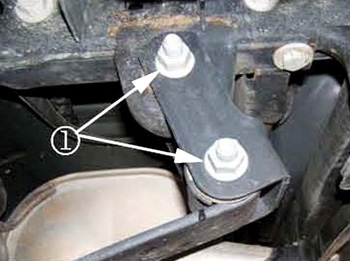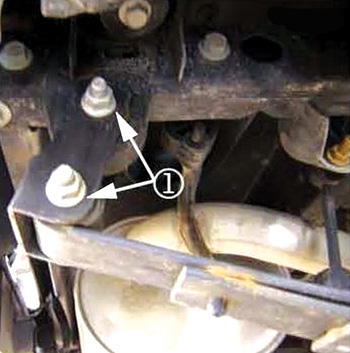By Chris Burton, ALLDATA editor and Jeff Webster,
ALLDATA technical writer
Some GM truck owners may complain that their vehicle appears to lean on one side. In most cases, the left front of the vehicle sits lower than the right front. The condition occurs because the rear leaf spring bushings or shackles may become loaded when the rear leaf spring shackle nuts are secured.
Follow the steps in this Tech Tip to correct the lean.
 Applicable Models: 2007-’09 Chevrolet Colorado, GMC Canyon and HUMMER H3, H3T
Applicable Models: 2007-’09 Chevrolet Colorado, GMC Canyon and HUMMER H3, H3T
Repair Procedure
Measure the fender wheel-opening heights, front and rear, to quantify vehicle lean. Fender wheel-opening heights are related to, but distinct from, trim height (a.k.a. Z and D height). The front wheel-opening height is known as P height, and the rear wheel-opening height is known as R height.
The P and R heights are not set at the factory, nor is a specification given for them. However, they are the most direct and repeatable measurement of what a customer would see as the vehicle leaning.
Perform the following steps before measuring the fender wheel-opening heights:
• Make sure the vehicle is on a level surface, such as an alignment rack.
• Set the tire pressures to the pressure shown on the certification label.
• Refer to Label – Vehicle Certification in General Information.
• Check the fuel level. Add additional weight if necessary to simulate a full tank.
• To ensure proper weight distribution, make sure the rear storage compartment and/or truck bed is empty.
• Close the doors and hood.
P Height and R Height Measurements
P height and R height are measured the same way. They are the distance from the ground to the highest point on their respective wheel-opening, going through the center of their respective wheel. Record the measurements on the repair order.
If the difference from left to right for P and R height is 10 mm (0.39”) or less, no repairs are suggested as the vehicle is within specification. If the difference exceeds 10 mm (0.39”) for either measurement, relax the rear spring shackles/bushings following the procedure below.
1. Raise and support the vehicle on the alignment rack.
2. Measure the P height (front wheel-opening height). Compare the left front measurement to the right front measurement.
3. Measure the R height (rear wheel-opening height). Compare the left rear measurement to the right rear measurement.
4. Loosen the left front rear leaf spring nut.
5. Loosen the two left rear leaf spring shackle nuts (Figure 1 – 1).
6. Loosen the right front rear leaf spring nut.
 7. Loosen the two right rear leaf spring shackle nuts (Figure 2 – 1).
7. Loosen the two right rear leaf spring shackle nuts (Figure 2 – 1).
Tip: You may need an assistant to help jounce the rear bumper.
8. Jounce the rear bumper three complete cycles to help exercise the chassis.
9. Tighten the left and right rear leaf spring shackle nuts to 63 lb.-ft. (85 Nm).
10. Tighten the left and right front rear leaf spring nuts to 92 lb.-ft. (125 Nm).
11. Verify that the lean condition is fixed.
12. If the condition still exists, perform the trim height inspection by measuring the Z and D heights.












